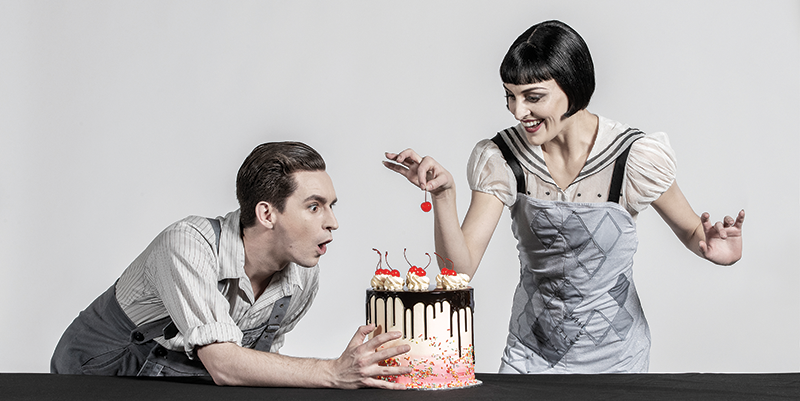
SOUNZ recently caught up with composer Claire Cowan to talk about 'Hansel & Gretel', a new evening-length ballet for the Royal New Zealand Ballet, choreographed by Laughlan Prior. 'Hansel & Gretel' is running 6 November to 14 December in 7 centres around the country. Book here.
How did the project come about?
Loughlan Prior approached me at the beginning of last year, knowing that he would be creating a full-length ballet for RNZB, and had his heart set on Hansel and Gretel. He also really wanted to work with me to create a new score for the show. We'd worked together on a few things before and always wanted to do something bigger. So, this felt like the perfect project to dive into the deep end together on.
What can the audience expect to see and hear?
It's inspired by early cinema, and 1920's expressionist films, so has a lot of little references to particular famous film characters / moments / stylistic traits. Act 1 is more black and white, and then Act 2 is the witch's world of enchantment and illusion so is a mix of saturated colour and grotesque gloom! The choreography fits the music precisely and has its roots in classical ballet but also has influences from tango, burlesque, cabaret, Broadway and even the world of drag. Because it's a story ballet, each character has their own way of moving, and the music reflects that. The Sandman for instance, who lights the moon and brings out the stars (and puts the children to sleep) has a quite mechanical geometric set of movements, almost like the inner workings of a clock - whilst Hansel has a childish imitative style to his movement - he watches the other characters and tries to do his best to copy. Gretel is spritely, cheeky and smart - and her movement is light and playful.
How does writing for dance compare to writing film or concert music?
Writing for ballet in particular is very satisfying, as the music created always comes first - and then the choreography is created in perfect synchronicity. However, it is more work as a composer than writing for film, as one has to imagine what's happening and create the action in the music to a very specific timeline. Sometimes down to the 10 second increment. The challenge is to make the music still function well in terms of all the musical aspects, whilst still hitting all the precise hit-points of the scene. I guess this is where my film scoring comes in handy!
What are you particularly proud of, or looking forward to in the show?
I'm particularly proud of the involvement I've had in so many different aspects of the production. Loughlan and I actually wrote the story together and nutted out all of the characters and worked out the structure of the thing to give the show the greatest possible momentum. There's never a dull moment! And also of completing it all in time and not dying trying! 100 minutes is a lot of music to orchestrate, and there were times where I definitely wanted to just put a final barline and be done with it.
 Claire Cowan (composer) and Laughlan Prior (choreographer). Photo: Garth Badger.
Claire Cowan (composer) and Laughlan Prior (choreographer). Photo: Garth Badger.
How does the process of writing an evening length ballet work?
Dividing it all into small chunks. I aimed for 1 minute a day during the composing process.
How was the story fleshed out?
We wrote a script, and then labelled each part with timings.
How did it change during the process?
It changed due to loads of things - practical engineering stuff with scene changes, flying people logistics, budget stuff, costuming issues, design requests. This was frustrating as early on I lost 20mins of music as we were asked to change a lot of aspects of our story to streamline the show.
How much input did Loughlan and other ballet staff have?
Loughlan and I had a lot of input, also Kate Hawley the designer. Then Drew Lees, the technical manager, and of course Patricia Barker the artistic director has final say.
Did you workshop any sections with dancers while you were writing?
Yes, Loughlan managed to get some dancers to work with quite early on, so we could test how various scenes were working. Things ended up changing because of the story changes, but we managed to salvage a lot of the material and repurpose it into new scenes.

How do you manage such a huge project practically?
Good question!! I had other projects on during the process, so I needed to be careful about my time management. It took around a year from the moment I started writing until stopping writing. But there were months where I had other work on which meant I had useful breaks from the ballet and I could come back with a fresh perspective. In the end I had 1 copyist, 2 orchestration assistants and a transfer Logic to Sibelius person too. One of my orchestration assistants was a jazz expert who helped me with expanding my knowledge of Jazz idioms, and certain stylistic traits of the 1920's music era. The other just helped me with further tidying and editing of my scores before I added additional orchestration.
The biggest thing that modern ballet composers have to deal with that their historical counterparts didn't - is that everything needs to be mocked up with MIDI, so the dancers have something to dance to before the orchestra comes in during production week. This meant using sample libraries and occasionally recording stuff along the way. All this information needs to be converted to scores and parts - the process of which takes a long time and can present many inaccuracies during the transfer. Tedious to say the least! Luckily, I had a team of people to help me in those final months, although I still had to work around the clock for the last month. Not much sleep was had!
What other projects do you have coming up?
I start a TV series soundtrack soon which is a supernatural thriller, and next year I have a couple of new projects with Loughlan. Hansel and Gretel has set us up for life as creative collaborators. It's been one thrilling ride!
SOUNZ blog is designed for expressive discussion and debate amongst the arts and broader community. This is intended to be a safe space so please remember to keep comments respectful and avoid personal attacks, criticisms of specific organisations and defamatory language. Comments are moderated to ensure that they comply with SOUNZ’s Community guidelines.
